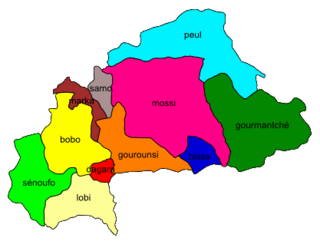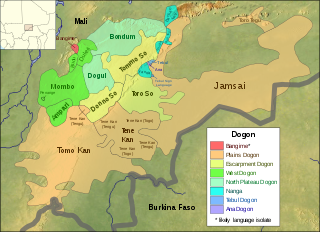
Fijian is an Austronesian language of the Malayo-Polynesian family spoken by some 350,000–450,000 ethnic Fijians as a native language. The 2013 Constitution established Fijian as an official language of Fiji, along with English and Fiji Hindi and there is discussion about establishing it as the "national language". Fijian is a VOS language.
Slavey is a group of Athabaskan languages and a dialect continuum spoken amongst the Dene peoples of Canada in the Northwest Territories – or central Denendeh – where it also has official status. The languages are primarily written using a modified Latin script, with some using Canadian Aboriginal syllabics. In their own languages, these languages are referred to as: Sahtúgot’įné Yatı̨́, K’ashógot’įne Goxedǝ́ and Shíhgot’įne Yatı̨́ in the North, and Dené Dháh, Dene Yatıé or Dene Zhatıé in the South.
Dagbani, also known as Dagbanli or Dagbanle, is a Gur language spoken in Ghana and Northern Togo. Its native speakers are estimated around 1,170,000. Dagbani is the most widely spoken language in northern Ghana, specifically among the tribes that fall under the authority of the King of Dagbon, known as the Yaa-Naa. Dagbon is a traditional kingdom situated in northern Ghana, and the Yaa-Naa is the paramount chief or king who governs over the various tribes and communities within the Dagbon kingdom.
Vaeakau-Taumako is a Polynesian language spoken in some of the Reef Islands as well as in the Taumako Islands in the Temotu province of Solomon Islands.
Sakao is an Oceanic language spoken on the northeast horn of Espiritu Santo, Vanuatu.
Tamambo, or Malo, is an Oceanic language spoken by 4,000 people on Malo and nearby islands in Vanuatu. It is one of the most conservative Southern Oceanic languages.
Apma is the language of central Pentecost island in Vanuatu. Apma is an Oceanic language. Within Vanuatu it sits between North Vanuatu and Central Vanuatu languages, and combines features of both groups.
Ughele is an Oceanic language spoken by about 1200 people on Rendova Island, located in the Western Province of the Solomon Islands.

Dagaare is the language of the Dagaaba people of Ghana, Burkina Faso, and Ivory Coast. It has been described as a dialect continuum that also includes Waale and Birifor. Dagaare language varies in dialect stemming from other family languages including: Dagbane, Waale, Mabia, Gurene, Mampruli, Kusaal, Buli, Niger-Congo, and many other sub languages resulting in around 1.3 million Dagaare speakers. Throughout the regions of native Dagaare speakers the dialect comes from Northern, Central, Western, and Southern areas referring to the language differently. Burkina Faso refers to Dagaare as Dagara and Birifor to natives in the Republic of Côte d'Ivoire. The native tongue is still universally known as Dagaare. Amongst the different dialects, the standard for Dagaare is derived from the Central region's dialect. Southern Dagaare also stems from the Dagaare language and is known to be commonly spoken in Wa and Kaleo.

Bangime is a language isolate spoken by 3,500 ethnic Dogon in seven villages in southern Mali, who call themselves the bàŋɡá–ndɛ̀. Bangande is the name of the ethnicity of this community and their population grows at a rate of 2.5% per year. The Bangande consider themselves to be Dogon, but other Dogon people insist they are not. Bangime is an endangered language classified as 6a - Vigorous by Ethnologue. Long known to be highly divergent from the (other) Dogon languages, it was first proposed as a possible isolate by Blench (2005). Heath and Hantgan have hypothesized that the cliffs surrounding the Bangande valley provided isolation of the language as well as safety for Bangande people. Even though Bangime is not closely related to Dogon languages, the Bangande still consider their language to be Dogon. Hantgan and List report that Bangime speakers seem unaware that it is not mutually intelligible with any Dogon language.
Paamese, or Paama, is the language of the island of Paama in Northern Vanuatu. There is no indigenous term for the language; however linguists have adopted the term Paamese to refer to it. Both a grammar and a dictionary of Paamese have been produced by Terry Crowley.
In linguistics, pluractionality, or verbal number, if not used in its aspectual sense, is a grammatical aspect that indicates that the action or participants of a verb is, or are, plural. This differs from frequentative or iterative aspects in that the latter have no implication for the number of participants of the verb.
Farefare or Frafra, also known by the regional name of Gurenne (Gurene), is a Niger–Congo language spoken by the Frafra people of northern Ghana, particularly the Upper East Region, and southern Burkina Faso. It is a national language of Ghana, and is closely related to Dagbani and other languages of Northern Ghana, and also related to Mossi, also known as Mooré, the national language of Burkina Faso.
Konkomba is a Gurma language spoken in Ghana, Togo and Burkina Faso.
Buli, or Kanjaga, is a Gur language of Ghana primarily spoken in the Builsa District, located in the Upper East Region of the country. It is an SVO language and has 200 000 speakers.
Medumba is a Bamileke language of Cameroon. The people who speak it originate from the Nde division of the West Region of the country, with their main settlements in Bangangté, Bakong, Bangoulap, Bahouoc, Bagnoun and Tonga. It is a major Bamileke language, and is located in an area where sacred kingship played a pivotal role in government, justice, and diplomacy. The modern history of the Bamileke area, which was a German colony placed under French trusteeship by the League of Nations in 1919, is closely associated with the nationalist movement of the Union des Populations du Cameroun (UPC), which developed primarily in the coastal hinterland (Bassa) and the western highlands (Bamileke). From 1956 to the late 1960s, this area of Cameroon experienced a period of unrest; this episode continues to shape Bamileke political culture, and has an impact on language identity and the linguistic landscape.
Tawala is an Oceanic language of the Milne Bay Province, Papua New Guinea. It is spoken by 20,000 people who live in hamlets and small villages on the East Cape peninsula, on the shores of Milne Bay and on areas of the islands of Sideia and Basilaki. There are approximately 40 main centres of population each speaking the same dialect, although through the process of colonisation some centres have gained more prominence than others.

Toʼabaita, also known as Toqabaqita, Toʼambaita, Malu and Maluʼu, is a language spoken by the people living at the north-western tip of Malaita Island, of South Eastern Solomon Islands. Toʼabaita is an Austronesian language.
Lengo or informally known as doku is a Southeast Solomonic language of Guadalcanal and is closely related to Gela language.
Neverver (Nevwervwer), also known as Lingarak, is an Oceanic language. Neverver is spoken in Malampa Province, in central Malekula, Vanuatu. The names of the villages on Malekula Island where Neverver is spoken are Lingarakh and Limap.




